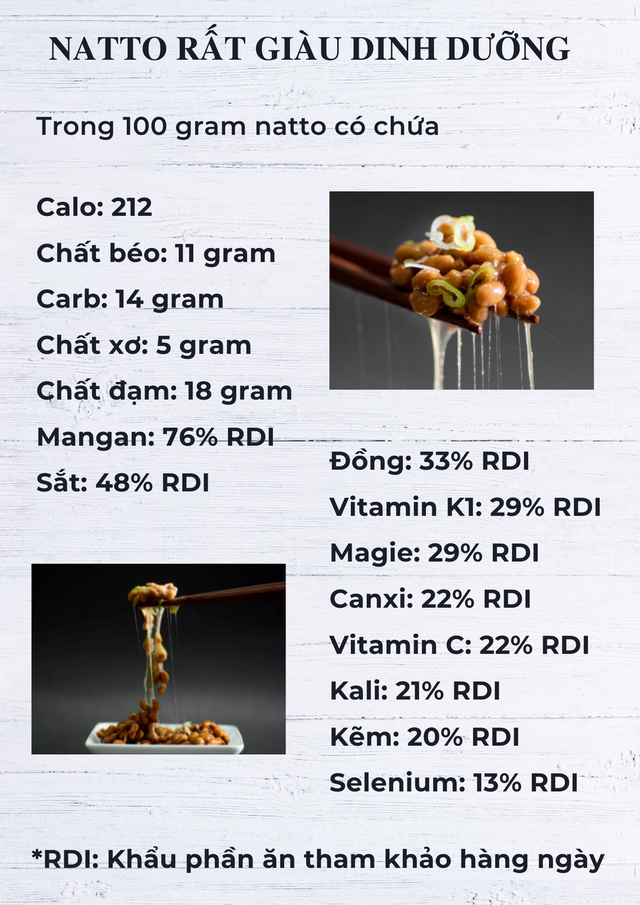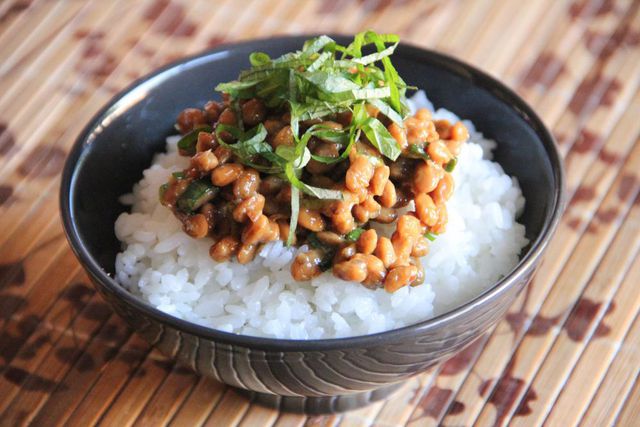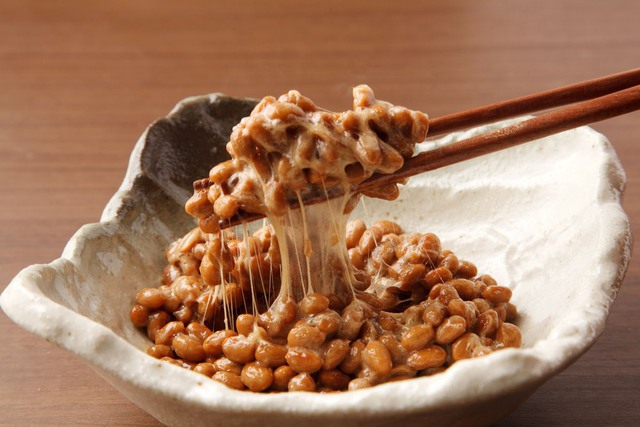An extremely good dish for the heart, the secret of Japanese longevity
Natto – Japanese longevity food
Natto, also known as fermented soybeans, is a traditional Japanese dish that has a sticky, gooey texture. Natto has a characteristic, slightly pungent smell that makes many people feel shy when trying it for the first time.
Regular consumption of natto is believed to be one of the reasons for the increased life expectancy of Japanese people, a lower risk of chronic disease, and a reduction in mortality from cardiovascular diseases.

In addition to the nutrients mentioned above, fermented soybeans also contain small amounts of vitamin B6, folate, and pantothenic acid as well as several healthful antioxidants.
Health benefits of natto
1. Good for the digestive system
The beneficial bacteria in natto can act as a protective barrier to help the digestive system fight toxins and harmful bacteria.
The probiotics and beneficial bacteria found in natto may help reduce bloating, constipation, and diarrhea, and ease symptoms of inflammatory bowel disease (IBD) and Crohn’s disease, researchers say. chronic wall) and ulcerative colitis.
Natural soybeans contain antinutrients (natural compounds found in plants) that interfere with the absorption of nutrients in the digestive system. However, natto fermentation reduces the content of natural antinutrients in soybeans, facilitating the digestion process.

Illustration: Eating fermented soybeans helps support the digestive system.
2. Strong bones
100 grams of natto provides 22% of the daily recommended amount of calcium – an essential mineral for bones. In addition, soybeans are one of the few plants that contain vitamin K2. Vitamin K2 is a nutrient that plays an essential role in bone health because vitamin K2 activates the protein osteocalcin, which helps attach calcium ions to the skeleton, preventing osteoporosis.
Studies show that vitamin K2 supplementation can slow age-related loss of bone density and can reduce the risk of fractures by 60-81%.
3. Protect your heart health
High blood cholesterol will lead to the formation of atherosclerotic plaques and blood clots – “invisible killers” for people with high blood pressure, varicose veins and people with high blood sugar. It is also considered the root cause of heart attack, brain infarction, stroke and some cardiovascular diseases.
Natto helps protect heart health because it is high in fiber and probiotics, both of which can help lower cholesterol levels.
Furthermore, natto fermentation produces nattokinase, an enzyme that helps dissolve blood clots, helps maintain the structure of blood vessels, improves blood flow, and reduces the risk of cardiovascular disease. Some studies have shown that nattokinase supplementation reduced blood pressure by about 3-5.5 mmHg in trial participants.

Illustration: Natto helps protect heart health.
4. Immune Booster
Natto contains a number of nutrients that help improve and strengthen the immune system, reduce the risk of infection and help the body recover quickly if sick.
In one four-month study, elderly people given B. subtilis, the beneficial bacteria found in natto, had a 55% lower risk of respiratory infections.
In addition, natto is rich in vitamin C, iron, zinc, selenium and copper, all of which play an important role in strengthening the body’s immunity.
Some other potential benefits
Lowers the risk of certain cancers: Natto contains isoflavones and vitamin K2, both of which may reduce the risk of certain types of cancer such as liver cancer, prostate cancer, and breast cancer.
Weight loss: Natto contains a large amount of probiotics and fiber, making the weight loss process more effective.
Improve brain health: Probiotic-rich foods like natto can help reduce stress, improve memory, and reduce symptoms of anxiety and depression.

Illustration: Natto brings many health benefits to the body.
Notes when using natto
Natto is almost safe for everyone. However, natto contains vitamin K1, which has a blood-thinning effect. Therefore, people who are taking anticoagulants should consult their doctor before adding natto to their diet.
In addition, in natto contains goitrogens – nutrients that interfere with the normal functioning of the thyroid gland. Therefore, people with impaired thyroid function need to limit the use of natto.
The nattokinase enzyme in fermented soybeans has the effect of reducing blood pressure. So, if you have low blood pressure or are taking medication to lower it, consult your doctor before eating natto.
How to cook fermented soybeans
Step 1: Wash the soybeans thoroughly under running water and then put them in the pot.
Step 2: Fill the beans with water and soak the beans for 9-12 hours or overnight. It is best to change the soaking water every 2-3 hours.
Step 3: After soaking for enough time, take out the beans to drain and put in a pot, fill with water to boil. You can use the pressure cooker to cook until tender for about 45 minutes, then remove and drain.
Step 4: Mix 15g of finished natto (canned natto) with a little hot water to form a paste. Then, mix this well with the soft boiled natto.
Step 5: Spread the mixture evenly into the ceramic pot or glass pot. Note to ensure that soybeans are exposed to the air.
Step 6: Cover the pot with aluminum foil and then incubate the beans for 22-24 hours at a temperature of 38-40 degrees Celsius. After incubation, you can enjoy natto.
2 bad summer habits that many people have that can form blood clots, increase the risk of cardiovascular diseases, even cause sudden death
at Blogtuan.info – Source: cafebiz.vn – Read the original article here



